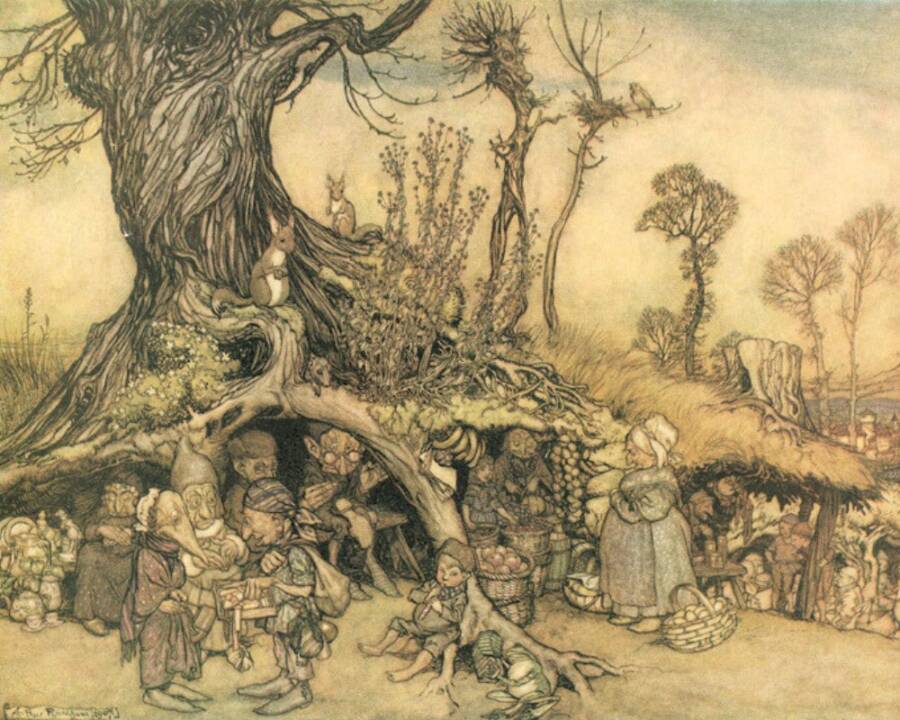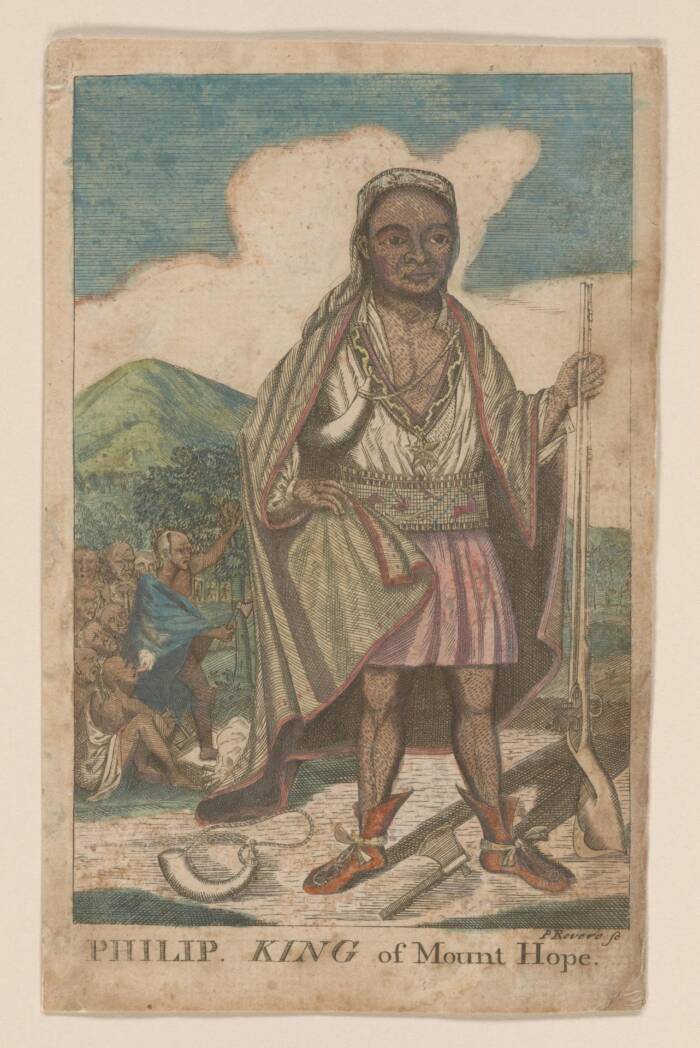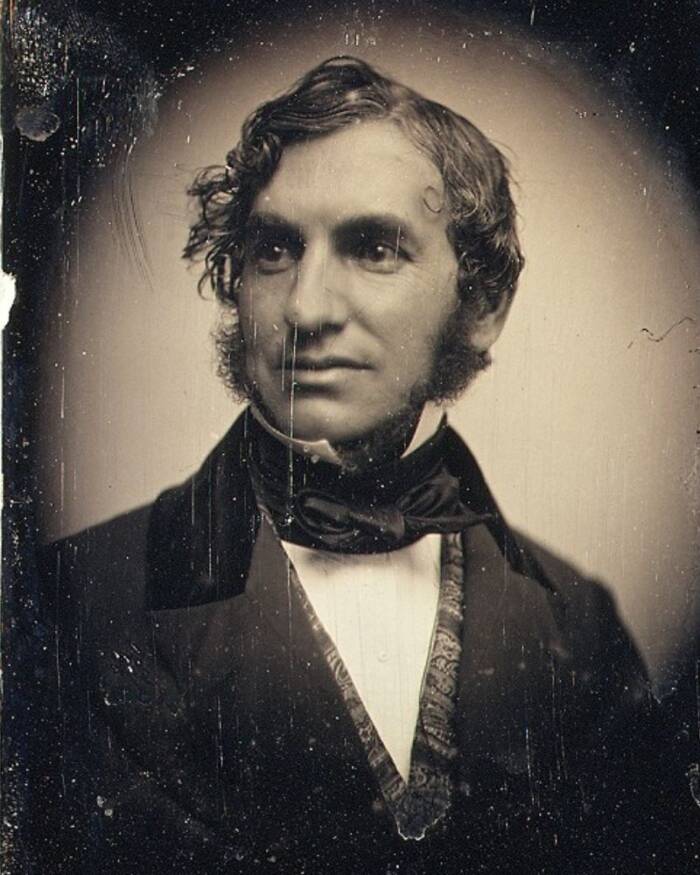While Pukwudgies are said to be good-hearted if treated kindly, they can become lethal when slighted — and they can use their magical powers to kill.

New York Public LibraryPukwudgies are often described as similar to gnomes or fairies, like those depicted in Arthur Rackham’s The Little People’s Market (1915).
Almost all cultures throughout history have their own cryptids, elusive beings whose existence has never been proven. In Wampanoag legend, that creature is the Pukwudgie.
Tiny and magical, Pukwudgies could be compared to gnomes or fairies of European folklore. Due to their penchant for teasing humans with harmless pranks, they appear rather charming compared to other mythical monsters. However, the knee-high pests also have a deadly side.
Pukwudgies have allegedly been known to lure victims into dangerous situations — or even right off of cliffs. Some versions of the legend claim that even their stare is lethal and that they can shape-shift into forest predators and make people forget things.
While not a single Pukwudgie has ever been captured for documentation, and many people have only heard of them because of their place in Harry Potter lore, the enduring tales about these mischievous cryptids continue to enchant believers to this day.
The Mysterious History Of The Pukwudgie
The word Pukwudgie, also spelled Puk-Wudjie or Bagwajinin, reportedly translates to “person of the wilderness.” Stories about these magical creatures are still told throughout New England and the Great Lakes regions today, but the legend seemingly originated with the Wampanoag tribe of Massachusetts and Rhode Island.
“Standing no more than three feet tall, the face of the pukwudgies have facial features similar to those of the Wampanoag people, however their ears, fingers, and noses are greatly enlarged and their skin is grey and smooth,” wrote Theresa Bane in the Encyclopedia of Fairies in World Folklore and Mythology.

Public DomainMetacomet, also known as King Philip, a Wampanoag chief in the 17th century.
The nature of these trickster entities is as disparate as the spelling of their name, as Indigenous folklore warns that Pukwudgies can be dangerous — if treated with disrespect. Those treated kindly are purportedly good-natured, while those who are slighted are said to be deadly.
Benevolent Pukwudgies may merely engage in harmless trickery with unsuspecting humans, and according to legend, they even helped Native Americans with manual labor on occasion. Their evil counterparts, however, are said to steal from children, dangerously sabotage people, and lure their enemies to death by leading them off of cliffs.
Bane wrote that they even cast magical “balls of light to lure victims into the woods where they are then killed or kidnapped.” According to Indigenous lore, the Pukwudgie’s primary nemesis was Maushop, the Wampanoag folk hero who purportedly created Nantucket.
In fact, some versions of the legend even claim Pukwudgies were behind Maushop’s death.
The Magical Powers Of This Wampanoag Cryptid
Pukwudgies are often described as forest creatures that stand knee-high and have a sweet smell. Their powers vary from tale to tale. Some stories say they turn invisible, shoot poisonous darts, kidnap children, or shape-shift into a creature that looks like a porcupine from the back and a half-human, half-troll from the front.
Wampanoag mythology suggests that Pukwudgies were initially friendly with humans, but they became jealous when the Wampanoag people started idolizing Maushop, a mythical giant. Feeling slighted, the creatures began playing mischievous pranks on humans.

Library of CongressAccording to Wampanoag legend, Pukwudgies are forest sprites that cause mischief ranging from harmless pranks to deadly attacks. This 1857 engraving depicts a Wampanoag man standing in the woods — where he may have been surrounded by Pukwudgies.
Members of the Wampanoag tribe started complaining about the Pukwudgies’ tricks, so Maushop exiled them by shaking them until they were confused and tossing them across America. Unfortunately, his plan backfired. The Pukwudgies returned with a vengeance — and their pranks soon turned deadly. As the story goes, they began kidnapping children, burning villages, and harming Wampanoag people.
Instead of dealing with them himself, Maushop sent his five sons to get rid of the Pukwudgies again. However, the creatures lured the boys into deep grass and killed them with their magical arrows. Another version of the legend claims that they killed Maushop, too.
Tales of the Pukwudgie aren’t limited to Native American lore, however.
Pukwudgie Sightings Throughout History
In 2023, a woman named Mary reportedly emailed the blog New England Folklore to report a Pukwudgie sighting. Mary claimed she was walking a dog between 4 and 5 a.m. when she saw a humanoid creature with black, matted fur and glowing eyes. When she told her co-workers about it the next day, they informed her it was probably a Pukwudgie.
More than 30 years prior to Mary’s Pukwudgie sighting, a man named Bill Russo reportedly saw a similar being while walking his own dog in 1990. The creature allegedly tried to lure him into the dark woods, but he managed to escape.
There are also rumors that Pukwudgies terrorize humans in Massachusetts’ Freetown State Forest. Several unexplainable deaths in recent years have allegedly been blamed on Pukwudgies luring people off of a towering cliff in the forest known as Assonet Ledge. The area is less than 20 miles from Hockomock Swamp, which some legends claim is the place where Pukwudgies originated.

Leonardo DaSilva/Wikimedia CommonsPukwudgies are said to lure unsuspecting victims off a rocky ledge in Massachusetts’ Freetown State Forest.
Tales of the Pukwudgie aren’t limited to New England, however. According to the Indiana Historical Society, the Lenape tribe has their own legends about the tiny cryptids. They reportedly lurk in forests in the state and play harmless pranks.
In 1927, a 10-year-old Indiana boy named Paul Startzman claimed that he was walking alone in a park when a two-foot-tall man with blonde hair appeared in front of him. Another resident named Eloise once recalled a group of small people with high-pitched voices who spoke in a strange language approaching her in a park.
Whether or not these stories are true is up for debate, but it’s undeniable that Pukwudgies have a grip on people’s imaginations — and on pop culture.
The Pukwudgie In Popular Culture
The legend of the Pukwudgie made its first appearance outside of folklore in 1855, when Henry Wadsworth Longfellow wrote “The Song of Hiawatha.” The epic chronicles the life of a fictional Ojibwe warrior and the tragic conclusion of his love for a Dakota woman.
The poem also relates the death of Hiawatha’s friend Kwasind — and his encounter with Pukwudgies. Longfellow wrote, “But the mischievous Puk-Wudjies, / They the envious Little People, / They the fairies and the pygmies, / Plotted and conspired against him.”
Longfellow went on to explain that the the only things that could kill Kwasind were the “seed-cone of the pine-tree” and the “blue cone of the fir-tree.” The Pukwudgies knew this secret, so they gathered up piles of the cones and “lay in wait for Kwasind.” Then, they ambushed and murdered him.

Metropolitan Museum of Art/Wikimedia CommonsA daguerreotype of Henry Wadsworth Longfellow around the time he wrote “The Song of Hiawatha.”
These deadly cryptids appear in much more recent pop culture, as well. J.K. Rowling named one of the four houses of Ilvermorny (Hogwarts’ American counterpart) Pukwudgie. The creatures even live at the school and act as “providers of security and maintenance.”
Rowling’s Pukwudgies are clearly not as evil — or as elusive — as the cryptids said to have caused countless deaths throughout history. Still, they enchant modern readers just as they captivated the minds of Wampanoag storytellers thousands of years ago.